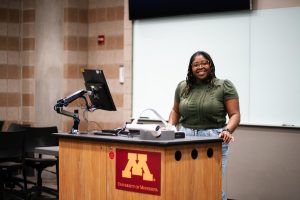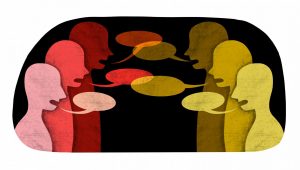glass ceilings to shatter,” she said.
University President Mark Yudof echoed Clinton’s comments moments later in his welcoming address.
“The challenges are great; the potential is even greater,” he said.
Conference coordinators Anita Rios and Jennifer Longnion knew the challenge to even hold a conference would be great, as well.
The duo and the rest of the Multicultural and Academic Affairs Department spent two years preparing for the event. More than 200 volunteers helped organizers set up and facilitate the conference.
Seeking equality in education
After the opening comments, speaker Johnnetta Cole livened up the audience with an impassioned speech describing the exact structure of the problems facing women in today’s collegiate community.
“If you educate a man, you educate a man,” the Emory University professor said. “If you educate a woman, you educate a nation.”
Cole said women and minorities have increased in all aspects of higher education, yet many of the appointments are for show.
Although the number of women in academia has increased steadily, she said many have been delegated to new departments such as women’s studies and African-American studies. Cole wants the female perspective represented equally in all departments.
She emphasized the need for women to become integral parts of the academic machine.
An example of the problem can be seen in university presidents. Of the more than 2,400 university presidents nationwide, 80 percent are white men.
“If equal opportunity cannot be achieved in the academic community — who are said to be rational, fair and equal — where in the world can it be achieved?” Cole said.
Shaping an agenda
After the national teleconference, participants divided up into 20 different caucus groups and devoted a large portion of each day to finding solutions. The caucuses were not part of the broadcast.
Participants chose to attend caucus topics ranging from Title IX to improving work environments and pay equity.
Sharon Doherty, director of the Center for Women at the College of St. Catherine in St. Paul, facilitated a caucus on “Preparing Women Students to Succeed in Work (and Influence the World).”
She said the goal of the caucuses is simple — to develop strategies to really make change.
“I want people’s voices heard the way they want to be heard,” Doherty said.
Each caucus group identified problems in its specific topic, then brainstormed and debated the correct strategies and solutions to improve the situation for women.
Information compiled after each three-session caucus will be used to form a piece of the national agenda expected to be completed in the next few months. It will then be submitted to legislators, university leaders and national organizations.
Based on the objectives formed in each caucus, participants are expected to return to their institutions and work toward change.
The University’s Office for Women will keep track of the progress made by the national agenda. Officials plan to document improvements in campus conditions for women after one year, then again after five years.
Participant Valdrie Walker said the caucuses are needed because women have awakened in the 1990s to find they dropped the ball.
“There are more of us in higher education than ever, but our position has not improved,” she said. “We became busy doinfg our jobs and forgot we need to sustain the effort.”
Some participants, however, were not as enthusiastic about the feasibility of enacting change.
Metropolitan State University student Amy Hartwell said the discussion focused too much on older women’s concerns and not enough on how to help current women students.
“I would like to see where (the caucus) is going,” she said, adding she was a little disenchanted any change would come from their efforts.
Hartwell’s fears about the conference came to fruition Tuesday when more than half of the participants skipped an Emerging Voices panel that included five young activists and scholars.
Some attendees voiced concern, citing the absences as an example of a lack of interest from older colleagues in what the younger generation has to say.
Diversity
Although many of the participants were women, a few men came to the event to gain a different perspective.
Jon Moreen, a College of Education and Human Development undergraduate, said he showed up to apply some of the conference’s ideologies to his future profession. He added many conference attendees tended to be either to the far left or far right politically.
“It’s great to see both sides of the fence,” he said.
The caucuses weren’t the only opportunities at the conference to gain perspectives.
Speakers, panels, poster sessions and performances filled in the gaps between caucus sessions.
University senior Maymangwa Flying Earth represented the student voice on a panel that included former university presidents and other high-ranking faculty members from across the country.
“I was nervous,” she said. “I was surrounded by women I’ve only read about.”
Augsburg College staff member Gail Nordmoe said the conference brought in a wide range of women like Flying Earth.
“Hopefully, by taking in different perspectives, we can work together,” she said.
Craig Gustafson welcomes comments at [email protected].







